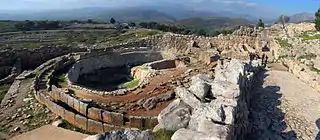Shaft tomb
A shaft tomb or shaft grave is a type of deep rectangular burial structure, similar in shape to the much shallower cist grave, containing a floor of pebbles, walls of rubble masonry, and a roof constructed of wooden planks.[1]



Practice
The practice of digging shaft tombs was a widespread phenomenon with prominent examples found in Mycenaean Greece; in Bronze Age China; and in Mesoamerican Western Mexico.[2]
Mycenaean Greece
Mycenaean shaft graves originated and evolved from rudimentary Middle Helladic cists, tumuli, and tholos tombs with features derived from Early Bronze Age traditions developed locally in mainland Bronze Age Greece 16th century BC.[3] Middle Helladic burials would ultimately serve as the basis for the royal Shaft Graves containing a variety of grave goods, which signified the elevation of a native Greek-speaking royal dynasty whose economic power depended on long-distance sea trade.[4]
The depth of Mycenaean shaft tombs would range from 1.0 m to 4.0 m with a mound constructed for each grave and stelae erected.[5] Archaeological examples include Grave Circle A and Grave Circle B.
Bronze Age China
Shaft graves were utilized by elites from the Shang Dynasty (or Yin Dynasty) during the Bronze Age 1200 BC of northern China.[2]
Mesoamerican Western Mexico
The Western Mexico shaft tomb tradition or shaft tomb culture refers to a set of interlocked cultural traits found in the present day western Mexican states of Jalisco, Nayarit, and, to a lesser extent, Colima to its south, roughly dating to the period between 300 BC and 400 AD. An example is the La Campana archaeological site of the Capacha and subsequent cultures.
See also
References
Citations
- Pedley 2011, p. 86.
- Kipfer 2000, "shaft grave", p. 508.
- Dickinson 1999, pp. 103, 106–107.
- Dickinson 1977, pp. 53, 107; Dickinson 1999, pp. 97–107; Anthony 2007, p. 48.
- Komita 1982, pp. 59–60.
Sources
- Anthony, David W. (2007). The Horse, the Wheel, and Language: How Bronze-Age Riders from the Eurasian Steppes Shaped the Modern World. Princeton, New Jersey: Princeton University Press. ISBN 978-0-691-05887-0.CS1 maint: ref=harv (link)
- Dickinson, Oliver (December 1999). "Invasion, Migration and the Shaft Graves". Bulletin of the Institute of Classical Studies. 43 (1): 97–107. doi:10.1111/j.2041-5370.1999.tb00480.x.CS1 maint: ref=harv (link)
- Dickinson, Oliver (1977). The Origins of Mycenaean Civilization. Götenberg: Paul Aströms Förlag.CS1 maint: ref=harv (link)
- Kipfer, Barbara Ann (2000), Encyclopedic Dictionary of Archaeology, New York: Springer, ISBN 978-0-306-46158-3CS1 maint: ref=harv (link)
- Komita, Nobuo (1982). "The Grave Circles at Mycenae and the Early Indo-Europeans" (PDF). Research Reports of Ikutoku Technical University (A-7): 59–70.CS1 maint: ref=harv (link)
- Pedley, John Griffiths (2011). Greek Art and Archaeology. Upper Saddle River, NJ: Prentice Hall. ISBN 978-0-20-500133-0.CS1 maint: ref=harv (link)
External links
- Horejs, Barbara; Pavúk, Peter, eds. (2007). "The Aegeo-Balkan Prehistory Project". The Aegeo-Balkan Prehistory Team.
- Rutter, Jeremy B. "Prehistoric Archeology of the Aegean". Hanover, NH: Dartmouth College.